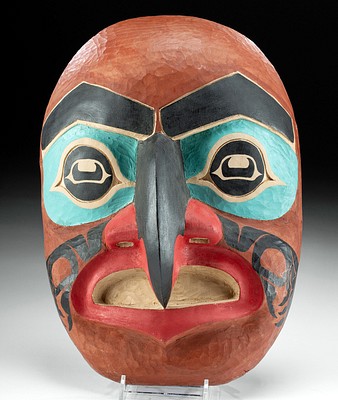16th C. Facon de Venise Glass Bottle w/ St. Nicholas
Lot 103
About Seller
Artemis Fine Arts
686 S Taylor Ave, Ste 106
Louisville, CO 80027
United States
Selling antiquities, ancient and ethnographic art online since 1993, Artemis Gallery specializes in Classical Antiquities (Egyptian, Greek, Roman, Near Eastern), Asian, Pre-Columbian, African / Tribal / Oceanographic art. Our extensive inventory includes pottery, stone, metal, wood, glass and textil...Read more
Categories
Estimate:
$2,200 - $3,300
Absentee vs Live bid
Two ways to bid:
- Leave a max absentee bid and the platform will bid on your behalf up to your maximum bid during the live auction.
- Bid live during the auction and your bids will be submitted real-time to the auctioneer.
Bid Increments
| Price | Bid Increment |
|---|---|
| $0 | $25 |
| $300 | $50 |
| $1,000 | $100 |
| $2,000 | $250 |
| $5,000 | $500 |
| $10,000 | $1,000 |
| $20,000 | $2,500 |
| $50,000 | $5,000 |
| $100,000 | $10,000 |
| $200,000 | $20,000 |
About Auction
By Artemis Fine Arts
Sep 2, 2021
Set Reminder
2021-09-02 12:00:00
2021-09-02 12:00:00
America/New_York
Bidsquare
Bidsquare : Summer Art Auction | Fine | Folk | Fun
https://www.bidsquare.com/auctions/artemis-gallery/summer-art-auction-fine-folk-fun-7395
Featuring visual treats from around the world, and back in time to present day - fine art, folk art, and fun artsy objects. Paintings. Sculptures. Textiles. More. Convenient in-house shipping. Artemis Fine Arts info@artemisgallery.com
Featuring visual treats from around the world, and back in time to present day - fine art, folk art, and fun artsy objects. Paintings. Sculptures. Textiles. More. Convenient in-house shipping. Artemis Fine Arts info@artemisgallery.com
- Lot Description
Europe, Western or Lowlands, Renaissance to Early Modern Period, ca. 16th to 17th century CE. A beautiful bottle formed from cristallo glass displaying an octagonal base and straight walls that rise to a curved shoulder, a narrow neck, and a flared, circular rim, all sitting upon applied, raspberry prunt feet. Translucent turquoise and cristallo glass rigaree decorates the 6 corners of the vessel, each travelling vertically down the vase's tall body and pincered in 4 vertical and 3 to 4 horizontal parts with a waffle pattern, while an additional wavy band of cristall glass wraps horizontally around the narrow-most point of the neck. The bust of Saint Nicholas of Bari is painted in red, white, and black pigments on one face of the vase, while the remaining 5 faces feature tulips painted in hues of pale pink and olive green. Size: 1.75" in diameter x 4.8" H (4.4 cm x 12.2 cm)
Popular in the 16th and 17th centuries, this style of glass is named "Facon de Venise," which is French for "Venetian fashion" and refers to glass made in places other than Venice using the techniques that had been perfected there.
Nicholas, a Greek bishop of Myra, Anatolia in the 4th century and one of the most beloved saints of the church, who served as an intercessor, performing miracles of healing and rescue, has an interesting history. A strong opponent of the heretical bishop Arius at the Council of Nicaea, Nicholas, after slapping Arius in the face, was denied his holy insignia and tossed in jail. However, Christ and the Virgin appeared to him and gave him back his freedom and his episcopal office. Saint Nicholas is often portrayed as a staunch champion of the Christian faith, a defender against heresy, and a healer.
Provenance: ex-private Medford, New Jersey, USA collection
All items legal to buy/sell under U.S. Statute covering cultural patrimony Code 2600, CHAPTER 14, and are guaranteed to be as described or your money back.
A Certificate of Authenticity will accompany all winning bids.
PLEASE NOTE: Due to recent increases of shipments being seized by Australian & German customs (even for items with pre-UNESCO provenance), we will no longer ship most antiquities and ancient Chinese art to Australia & Germany. For categories of items that are acceptable to ship to Australia or Germany, please contact us directly or work with your local customs brokerage firm.
Display stands not described as included/custom in the item description are for photography purposes only and will not be included with the item upon shipping.
#165933Rough pontil scar on base. A pontil scar or mark indicates that a vessel was free-blown, while the absence of such a mark suggests that the work was either mold-blown or that the mark was intentionally smoothed away or wore away over time. Losses to bottom of 1 rigaree and 2 feet. Otherwise, excellent with nice remaining pigments.Condition
- Shipping Info
-
All shipping is handled in-house for your convenience. Your invoice from Artemis Gallery will include shipping calculation instructions. If in doubt, please inquire BEFORE bidding for estimated shipping costs for individual items.
-
- Buyer's Premium



 EUR
EUR CAD
CAD AUD
AUD GBP
GBP MXN
MXN HKD
HKD CNY
CNY MYR
MYR SEK
SEK SGD
SGD CHF
CHF THB
THB














